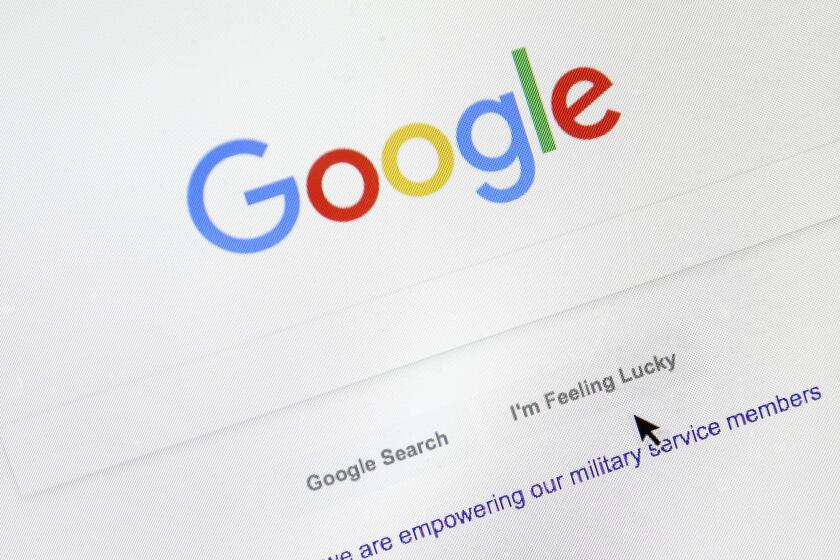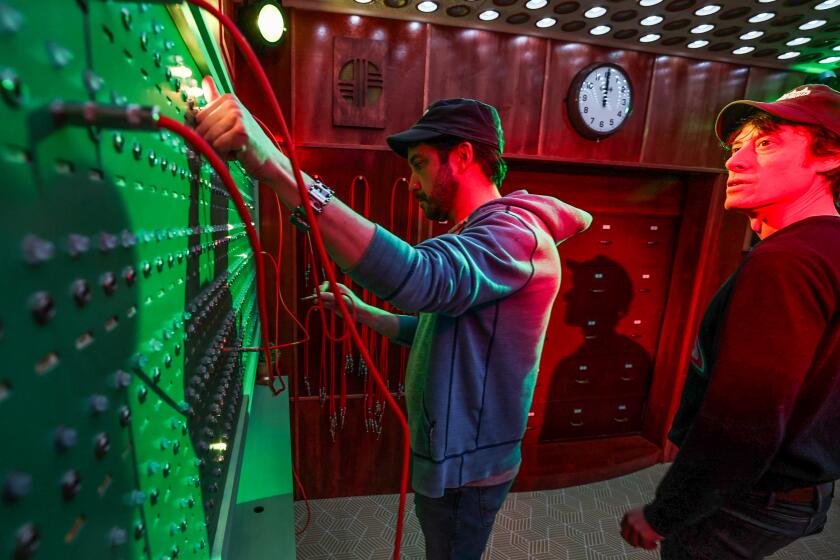2008 hurdle: turning clicks to knocks
The handful of people who have gathered on the patio of a Pasadena coffeehouse are either the answer, or the big question mark, in the upcoming presidential election.
They have come at the behest of Mike Barako, a Los Angeles special-ed teacher who has been following Sen. Barack Obama (D-Ill.). Last month, Barako launched a website through Obama’s online campaign to build a local committee of active supporters. More than two dozen people promised to come out for this night’s organizational meeting.
But only eight people have shown up, pointing up one of the challenges of the 2008 presidential campaigns’ rush to the Internet. Building an online database of supporters and the curious is one thing. Spurring them to action is another.
“That’s going to be the test ... whether you can capture the lightning in the bottle and turn that into people who will go door to door for you,” said Michael Turk, who ran the Internet operation for the 2004 Bush-Cheney campaign. “How are you going to turn those people into true supporters and do the kind of things that win campaigns?”
It’s still early in the campaign cycle, but nearly all the major 2008 presidential candidates -- both announced and presumed -- are wrestling with the technology that has made such successes of MySpace, Facebook, MeetUp and other social networking sites.
Yet in their rush to the Web world, the campaigns have stumbled as much as they’ve succeeded. Two bloggers with embarrassing baggage quit former Sen. John Edwards’ campaign under pressure over earlier comments bashing Catholics. And some say McCainSpace, a social networking site, emphasizes fundraising over network building.
Of the major declared and anticipated candidates, those who have moved most aggressively to the Internet are Obama; Edwards; Sen. John McCain (R-Ariz.); Sen. Hillary Rodham Clinton (D-N.Y.); and former Massachusetts Gov. Mitt Romney, a Republican.
Their sites let supporters create their own campaign-linked pages, find one another through regional search mechanisms, download posters and signup sheets, raise money and, in the case of Obama, print out voter registration forms.
According to staff lists maintained by George Washington University’s Democracy in Action, many of the campaigns have turned to 2004 veterans to oversee their Web projects: Former Howard Dean staffers Matthew Gross and Joe Rospars work for Edwards and Obama, respectively; John F. Kerry advisor Peter Daou is with Clinton; former Bush-Cheney webmaster and Republican blogger Patrick Ruffini works for former New York Mayor Rudolph W. Giuliani; and Mindy Finn, a Bush-Cheney 2004 veteran and former deputy campaign director of the Republican National Committee, works for Romney.
Web use also reflects differing views on campaigning, Turk said. Democrats have been more nimble because Democrats tend to be more receptive to hearing from the base on policy matters and strategy, whereas Republican candidates tend to adopt a more corporate, top-down structure, he said.
“The Republican Party has always been the message-driven party,” Turk said, adding that the GOP was effective with direct mail, television and talk radio formats, “which are traditional sender-receiver models.”
“The Internet just blows that out, and the presidential candidates haven’t adapted to it yet.”
So far, Obama’s campaign has been the most adept at using the Internet, Turk and others said. Obama’s campaign has created My.BarackObama.com, its own version of My Space.com, allowing supporters to come together with minimal contact or control from the campaign itself, which the campaign hopes will speed efforts to build an online grass-roots network, or “netroots.”
“We’re trying to provide people with the focused tools to take organizing into their own hands, and we’re seeing people rising to the challenge,” Obama spokeswoman Jen Psaki said.
In the first two weeks, supporters used My.Barack Obama.com to launch more than 6,500 blogs, 4,000 personal fundraising pages and 3,000 local volunteer groups, she said.
But there have been stumbles in the various campaigns, and of course there’s a website to track them: TechPresident .com, whose bloggers have noted the Edwards campaign’s awkward embrace of text-messaging cellphone technology (one commenter signed up but never received text messages), and the trashing of “virtual campaign offices” created by Edwards supporters in the imaginary world of Second Life.com.
Gross, Edwards’ online expert, said such problems were the consequences of moving quickly into uncharted waters.
“There’s a newness to it, and some of the guidelines and rules are not fully known,” Gross said, adding that the text-message program is still being set up. “The challenge is for people to continue to engage in what is essentially a shifting media landscape.”
One tactic that earned endorsements from Web watchers: McCain’s crew posted his picks for the NCAA men’s basketball tournament and let supporters compete against him in an online pool. MySpace.com joined the fray itself this week, offering impact.myspace.com, which links all the major candidates’ MySpace sites, echoing YouTube.com’s You Choose ’08 (www.youtube.com/youchoose) linking to posted videos of the candidates.
But the effect remains unclear. Obama leads the pack in MySpace “friends” -- people with their own pages who have linked to Obama’s page -- with about 81,000 by Sunday evening, a minuscule presence compared with the 122 million votes cast in the last presidential election.
And Web observers say that though the campaigns have sought to build on the 2004 Dean and Bush campaigns’ groundbreaking tactics in networking with supporters, raising cash and spawning local letters to the editor, none has exploited more than a small fraction of the Web’s potential.
“There’s not a doubt that they can use it smartly, but I don’t think any of them are using it very well,” said David L. Sifry, founder of Technorati, which monitors live Web traffic. “Some of them are trying to jump on top of the MySpace bandwagon or jump on the social networking phenomenon.... But I don’t think any of them are coming up with that breakthrough idea that gets young people engaged.”
The social networking sites could prove more successful in reaching older people, who are more likely to vote. Web monitor Media Metrix reported in the fall that two-thirds of MySpace users and about half of Facebook users were 25 or older.
Zephyr Teachout, a key member of Dean’s 2004 Web campaign who recently advised the Obama campaign, said of social networking sites: “They can be extremely effective organizing tools, but candidates may foolishly choose to use them as measurements of celebrity ... and let a lot of organizing potential go down the drain.”
All the candidates who flock to the social networking sites also have to be wary of who their online “friends” are. The higher the number, the bigger the risk that some are pushing porn, racist views or other material that an opposition researcher could pounce on.
“I think it’s a landmine just sitting there,” Turk said.




